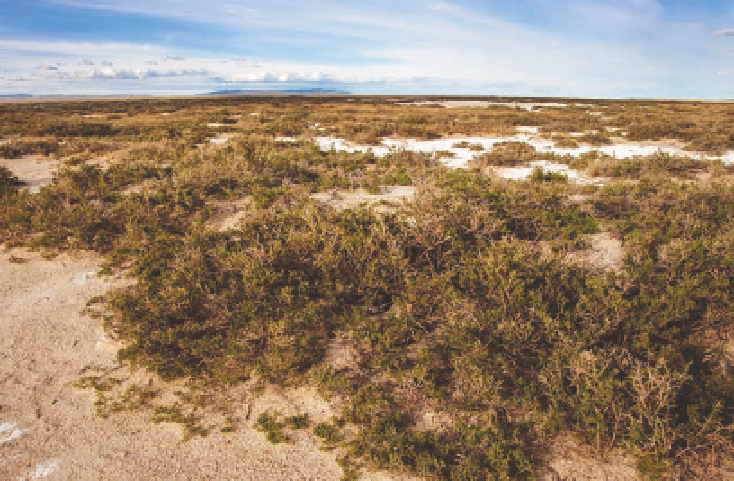Geoscience Reference
In-Depth Information
different species tap different parts of the ecosystem for
the water and nutrients they need (see chapter 6). one
study focused on how coexisting winterfat and shadscale
winterfat, a c
3
species, is capable of rapid photosynthesis
in the spring and then becomes relatively inactive during
the rest of the year, when moisture is limiting. in con-
trast, shadscale, a c
4
species, has moderate rates of photo-
synthesis throughout the growing season, about half that
of winterfat in the spring but two times faster in the sum-
mer. Both species have a high tolerance for water stress,
and both are able to fix carbon at low temperatures—an
important adaptation for the cool, short growing season
that characterizes northern deserts. Differences between
the two species help explain how they coexist. other des-
ert shrubs have similar adaptations.
Sharp spines are another notable adaptation of some
desert shrubs, especially those that are palatable. this
adaptation minimizes grazing in an environment where
the production of plant tissue is slow. examples are
greasewood, spiny hopsage, bud sagewort, and shadscale.
Also, like big sagebrush, some desert shrubs produce both
ephemeral and overwintering leaves, improving the effi-
shrubland, saltgrass meadow, desert grassland, saltbush
shrubland, and mixed desert shrubland. Greasewood
shrubland and saltgrass meadow are characteristic of
comparatively wet depressions (fig. 8.4), as described
in chapter 5, but they also are found on some slopes
where water seeps to the surface, as sometimes occurs
in badlands. the desert grassland community occurs
where soils are drier and less saline, where drainage is
not impeded by fine-textured soils, and on the lee sides
of slopes where snowdrifts occur. Saltbush shrubland
is the community with the highest salinity and has an
abundance of plants in the genus
Atriplex.
the fifth com-
munity, mixed desert shrubland, is found on soils that
are intermediate in salinity and have a diversity of shrub
species. Sagebrush steppe is sometimes thought of as
desert shrubland, but it occurs at slightly higher eleva-
tions or where annual precipitation is somewhat greater.
As described in chapter 7, the sagebrush community has
a higher cover of perennial grasses and is likely to burn
more frequently than desert shrub vegetation.
Greasewood does not tolerate long periods of
drought. A deciduous shrub, it commonly grows to
a height of 3 feet or more, and the roots have been
observed at depths of 10 feet. Because of salt glands
on the leaves, soil salinity under the shrub is typically
seedlings can survive under the parent shrubs where
the salinity is highest, though germination occurs
early in the spring when the soil solution is less saline
The Desert Mosaic
Five communities can be easily identified in the des-
ert mosaic, based on the dominant plants: greasewood
Fig. 8.4. Greasewood shrublands in
the Great Divide Basin. Saltgrass and
Gardner's saltbush are also common
in this area. the soil surface is often
white, because salts accumulate as water
evaporates. elevation 6,550 feet. Photo
by Ken Driese.

Search WWH ::

Custom Search